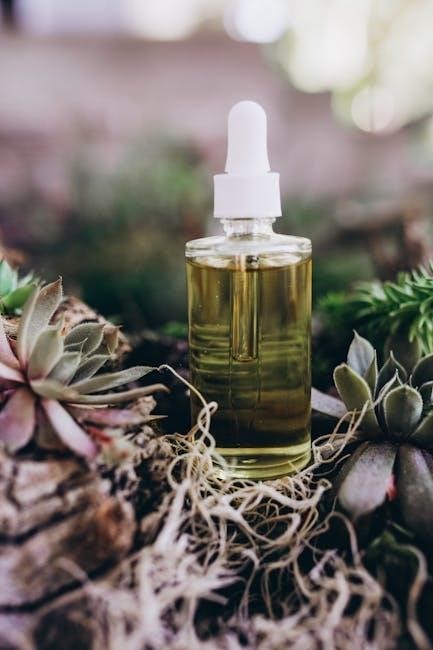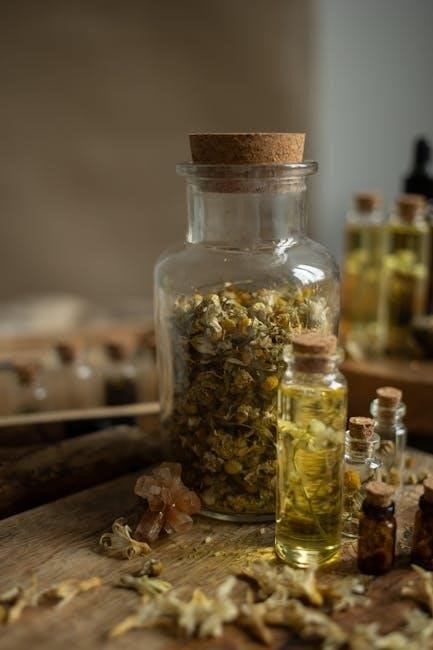herbs in the bible for healing pdf
The Bible is a rich source of knowledge about herbs used for healing, offering insights into their spiritual and medicinal properties. Plants like frankincense, myrrh, and hyssop are highlighted for their holistic health benefits, bridging ancient traditions with modern wellness practices.
1.1 The Significance of Plants in the Bible
Plants hold a profound significance in the Bible, often symbolizing life, divine provision, and spiritual renewal. From the Garden of Eden to the Tree of Life, vegetation is portrayed as a gift from God, essential for sustenance and healing. The Bible frequently mentions plants in the context of rituals, worship, and natural remedies, highlighting their dual role in physical and spiritual well-being; Herbs like hyssop and frankincense are referenced for their cleansing and aromatic properties, while others, such as figs and olives, are celebrated for their nutritional and medicinal value. The biblical emphasis on plants reflects a deep connection between nature and humanity, underscoring the idea that creation itself holds the keys to health and vitality. This holistic view of plants has inspired centuries of traditional healing practices, blending faith and natural wisdom.
1.2 Historical Use of Herbs for Healing
The historical use of herbs for healing is deeply rooted in ancient cultures, with the Bible serving as a testament to their significance. Plants and herbs were integral to traditional medicine, often used in rituals, remedies, and daily life. The ancient Egyptians, for instance, utilized sage tea to enhance fertility, while thyme was valued for its cleansing properties. These practices influenced biblical traditions, where herbs became central to both physical and spiritual well-being. The Bible highlights the role of herbs in purification rites, such as the use of hyssop for cleansing, and their incorporation into sacred anointing oils. Over centuries, these herbal traditions evolved, blending spiritual beliefs with practical healing methods. Today, the historical use of herbs continues to inspire modern herbalism, offering a bridge between ancient wisdom and contemporary health practices. This enduring legacy underscores the timeless value of nature’s remedies in human history.

Historical Context of Healing Herbs in the Bible
The Bible provides a historical backdrop where plants and herbs were central to rituals and healing. Frankincense, myrrh, and hyssop were used in purification and medicinal practices, reflecting ancient wisdom.

2.1 Medicinal Plants Mentioned in the Bible
The Bible references various medicinal plants used for healing and spiritual purposes. Hyssop, mentioned in Psalm 51:7, was used for cleansing rituals. Frankincense and myrrh, found in Matthew 2:11, were valued for their aromatic and healing properties. Aloe vera, noted in John 19:39, was used to soothe skin conditions. Nard, referenced in Mark 14:3, was a costly spice used for anointing. These plants were integral to ancient practices, combining spiritual significance with practical health benefits.
2.2 The Role of Herbs in Ancient Jewish and Christian Practices
In ancient Jewish and Christian traditions, herbs played a vital role in religious rituals, healing, and daily life. Hyssop, for instance, was used in Jewish cleansing rituals, as mentioned in Psalm 51:7. Similarly, frankincense and myrrh were integral to worship, symbolizing prayer and sacrifice. Early Christians adopted many of these practices, incorporating herbs into anointing ceremonies and healing rites. Herbs were not only valued for their medicinal properties but also for their spiritual significance, bridging the physical and divine; This dual purpose reflects the holistic approach to health and spirituality in both traditions, where nature was seen as a gift from God for humanity’s well-being.
2.3 Biblical References to Herbal Remedies
The Bible contains numerous references to herbs used for healing and medicinal purposes. In Psalm 23:5, anointing with oil symbolizes healing and comfort; Isaiah 38:21 mentions using figs to treat boils, showcasing their practical application. Herbs like hyssop and myrrh are frequently cited for their cleansing and restorative properties. These references highlight the reliance on natural remedies in biblical times, emphasizing their effectiveness and divine endorsement. The integration of herbal remedies into daily life and worship underscores a deep understanding of nature’s healing power, providing a foundation for modern holistic health practices inspired by ancient wisdom.

Major Herbs in the Bible for Healing
The Bible highlights several herbs renowned for their medicinal properties, such as frankincense, myrrh, and hyssop. These plants are celebrated for their cleansing, restorative, and aromatic benefits.
3.1 Hyssop (Origanum syriacum)
Hyssop, or Origanum syriacum, is one of the most significant herbs mentioned in the Bible, particularly for its purification and healing properties. It is noted in Psalm 51:7, where it is used for spiritual cleansing. Hyssop was traditionally employed in rituals for purification and to treat various ailments. Its antiseptic and anti-inflammatory qualities make it effective for wound care and respiratory issues. In ancient times, hyssop was also used in teas and infusions to promote overall health. Today, it continues to be valued for its aromatic and medicinal benefits, often used in herbal remedies and natural health practices.
3.2 Frankincense (Boswellia sacra)
Frankincense, derived from the resin of the Boswellia sacra tree, holds a revered place in biblical history. It is notably mentioned in Matthew 2:11 as one of the gifts brought by the Magi to the newborn Jesus, symbolizing its value for worship and healing. Frankincense has been used for centuries to treat pain, reduce inflammation, and promote spiritual well-being. Its aromatic properties make it a staple in rituals and therapeutic practices. In ancient times, it was burned to purify the air and uplift the spirit. Modern research highlights its anti-inflammatory and anti-arthritic benefits, making it a popular ingredient in natural remedies and aromatherapy. Frankincense remains a bridge between ancient traditions and contemporary holistic health, offering both physical and spiritual healing.
3.3 Myrrh (Commiphora molmol)
Myrrh, extracted from the resin of the Commiphora molmol tree, is another highly revered herb in biblical texts. It is notably mentioned in Matthew 2:11 as one of the gifts presented to Jesus, symbolizing its sacred and healing properties. Myrrh has been used for centuries to treat wounds, reduce pain, and combat infections due to its antiseptic and anti-inflammatory qualities. In ancient practices, it was applied topically to promote skin health and relieve swelling. The Bible also references myrrh in John 19:39, where it was used in the burial of Jesus, highlighting its significance in both spiritual and medicinal rituals. Today, myrrh is valued in aromatherapy and natural remedies for its ability to soothe physical ailments and uplift the spirit, making it a timeless element of holistic healing.
3.4 Galbanum (Ferula gummosa)
Galbanum, derived from the Ferula gummosa plant, holds a significant place in biblical history, particularly in Exodus 30:34, where it is listed as an ingredient in the holy incense used in Temple worship. This resinous herb has been valued for its earthy, aromatic properties and medicinal benefits. Historically, galbanum was used to treat inflammation, skin ailments, and respiratory issues due to its anti-inflammatory and antiseptic qualities. Its ability to purify and cleanse made it a staple in sacred rituals, symbolizing spiritual purification. In modern times, galbanum is incorporated into aromatherapy for its grounding effects and used in skincare products for its healing properties. This versatile herb bridges ancient religious practices with contemporary wellness, showcasing its enduring relevance in natural healing traditions.
3.5 Nard (Nardostachys jatamansi)
Nard, or Nardostachys jatamansi, is one of the most expensive and highly valued herbs in the Bible, famously mentioned in the Story of the Anointing of Jesus (John 12:3). This aromatic plant, native to the Himalayas, was used to create a luxurious perfume and medicinal ointment. Its fragrance was considered a symbol of purity and devotion. Nard’s rhizomes contain compounds with anti-inflammatory and sedative properties. In ancient times, it was used to treat skin conditions, reduce pain, and promote relaxation. The high cost of nard made it a symbol of extravagant love and sacrifice, as seen in the biblical account. Today, nard is still used in traditional medicine and aromatherapy, offering a bridge between ancient practices and modern holistic health. Its enduring popularity underscores its remarkable healing and spiritual significance across centuries.
3.6 Aloe Vera (Aloe barbadensis)
Aloe vera, a succulent plant with thick, gel-filled leaves, is renowned for its healing properties and is mentioned in the Bible as a symbol of purity and health. In John 19:39, it is noted that Nicodemus brought aloe vera, along with myrrh, to anoint Jesus’ body after his crucifixion. This plant has been used for centuries to treat skin conditions, burns, and wounds due to its soothing and moisturizing effects. The clear gel inside the leaves contains vitamins, minerals, and amino acids, which promote skin repair and reduce inflammation. Aloe vera was also valued for its anti-inflammatory and antiseptic properties, making it a natural remedy for various ailments. Today, it remains a popular ingredient in skincare products and natural remedies, continuing its legacy as a timeless healing herb with both practical and spiritual significance.
3.7 Fig (Ficus carica)
The fig tree, with its lush green leaves and sweet fruit, holds a significant place in biblical narratives and healing traditions; In the Bible, figs are mentioned as a source of food and medicine, with references in 2 Kings 20:7, where a poultice made from figs is used to heal King Hezekiah’s boil. The fig’s latex contains enzymes with anti-inflammatory properties, making it effective for treating skin irritations and wounds. Additionally, figs are rich in antioxidants and dietary fiber, contributing to overall health. Historically, figs were used to treat a variety of conditions, from digestive issues to skin infections. Their versatility and natural healing properties have made them a cherished remedy in both ancient and modern times, reflecting their enduring value as a biblical herb for wellness.
3.8 Rosemary (Rosmarinus officinalis)
Rosemary, a fragrant and versatile herb, holds a special place in biblical and traditional healing practices. Although not directly mentioned in the Bible, its aromatic properties and medicinal benefits align with the holistic healing principles found in Scripture. Rosemary has been used for centuries to enhance memory, improve digestion, and boost mental clarity. Its essential oils contain antioxidants and anti-inflammatory compounds, making it effective for treating joint pain and skin conditions. In ancient times, rosemary was burned in homes and temples to purify the air and ward off illnesses. Today, it is incorporated into teas, infusions, and aromatherapy for its therapeutic effects. The herb’s enduring popularity reflects its alignment with biblical wisdom, which emphasizes the natural world as a source of healing and wellness. Rosemary remains a powerful symbol of nature’s ability to nurture both body and spirit.
Healing Properties and Uses of Biblical Herbs
Biblical herbs possess remarkable healing properties, offering antiseptic, anti-inflammatory, and pain-relieving benefits. They are used in teas, infusions, and aromatherapy, enhancing physical and spiritual well-being while aligning with ancient traditions.
4.1 Antiseptic and Anti-inflammatory Properties
Biblical herbs are renowned for their antiseptic and anti-inflammatory properties, making them highly effective in treating wounds and reducing inflammation. Frankincense and myrrh, for instance, have been used for centuries to cleanse and heal, while hyssop is noted for its antiseptic qualities. These herbs contain compounds that inhibit the growth of harmful bacteria and fungi, promoting faster recovery. Additionally, their anti-inflammatory properties help alleviate swelling and pain, making them ideal for skin conditions and injuries. Modern studies have validated these traditional uses, confirming the scientific basis behind their effectiveness. Many of these herbs are still used today in topical applications, such as ointments and salves, to treat burns, infected wounds, and inflammation. Their natural healing powers continue to inspire modern herbal remedies, bridging ancient wisdom with contemporary medicine for holistic well-being.
4.2 Pain Relief and Wound Healing
Biblical herbs have long been valued for their ability to alleviate pain and promote wound healing. Frankincense and myrrh, for example, contain compounds that reduce inflammation and discomfort, making them effective for pain relief. Aloe vera, mentioned in the New Testament, is renowned for its soothing gel, which accelerates the healing of burns and skin irritations. These herbs have been used historically to treat a variety of ailments, from wounds to arthritis, due to their natural analgesic and restorative properties. Their anti-inflammatory and pain-relieving effects have been validated by modern scientific studies, confirming their efficacy. Today, they continue to be used in natural remedies and holistic treatments, offering a safe and effective alternative to synthetic painkillers. The timeless wisdom of biblical herbs provides a natural pathway to managing pain and facilitating healing, aligning with modern health practices.
4.3 Spiritual and Aromatic Uses
Biblical herbs have played a significant role in spiritual practices and rituals, often used for their aromatic properties to create sacred spaces and promote emotional well-being. Frankincense and myrrh, mentioned in both Old and New Testaments, were burned as incense in temples to purify the air and connect with the divine. Aloe vera was also valued for its soothing scent and used in spiritual cleansing rituals. These herbs were believed to carry prayers to heaven and ward off negative energies. Their fragrance was thought to uplift the spirit and foster a sense of peace. In modern times, these herbs are still used in aromatherapy and holistic practices to promote relaxation and spiritual balance. Their aromatic qualities continue to bridge the gap between ancient traditions and contemporary wellness, making them timeless tools for both spiritual and physical harmony.

Modern Applications of Biblical Herbs
Biblical herbs are now integrated into herbal supplements, skincare products, and aromatherapy, offering natural wellness solutions. Their timeless properties continue to inspire modern health practices, blending tradition with innovation.
5.1 Herbal Supplements and Adaptogens
Modern herbal supplements often incorporate biblical herbs, harnessing their natural properties for wellness. Adaptogens like frankincense and myrrh are valued for their ability to balance bodily systems and reduce stress. These herbs, mentioned in ancient texts, are now formulated into capsules, powders, and tinctures for easy consumption. Products like “Wisdom Nutrition” blend eight biblical herbs to enhance health and vitality. Frankincense, known for its anti-inflammatory properties, is used in aromatic balms and skincare. Myrrh, traditionally a healing resin, is now found in supplements promoting immune support. The integration of these herbs into contemporary wellness reflects their enduring relevance. By combining ancient wisdom with modern science, these supplements offer a natural approach to health, aligning with the holistic healing principles outlined in the Bible;

5.2 Biblical Herbs in Contemporary Medicine
Biblical herbs have found a place in contemporary medicine due to their proven therapeutic properties. Frankincense, for instance, is studied for its anti-inflammatory and anticancer potential, with its active compound, boswellic acid, being used in modern treatments. Similarly, myrrh is valued for its antimicrobial and anti-inflammatory effects, often incorporated into skincare and wound-healing products. Aloe vera, mentioned in the Bible, is widely used in dermatology for its soothing and regenerative properties. Even hyssop and galbanum are being researched for their antioxidant and antiseptic qualities, offering natural alternatives in pharmaceuticals. These herbs, once used in ancient rituals and remedies, are now backed by scientific evidence, making them integral to modern medicine. Their versatility and efficacy highlight the enduring connection between biblical wisdom and contemporary healthcare practices.
5.3 Herbal Teas and Infusions
Biblical herbs have become increasingly popular in herbal teas and infusions, offering natural health benefits and spiritual connections. Herbs like hyssop, frankincense, and myrrh are often brewed for their cleansing and soothing properties. These teas are believed to promote relaxation, reduce inflammation, and support immune function. Aloe vera and nard are also used in infusions for their calming and restorative effects. Many modern herbal blends incorporate these biblical plants, blending tradition with contemporary wellness practices. The popularity of herbal teas has grown, with products now widely available in health stores and online. Users often appreciate their natural, holistic approach to health, aligning with the timeless wisdom of the Bible. These teas not only provide physical benefits but also serve as a connection to ancient healing traditions, making them a cherished choice for many seeking natural remedies.
Biblical herbs remain a timeless testament to nature’s healing power, offering versatile remedies that bridge ancient traditions with modern holistic health practices, enriching both body and spirit.
6.1 The Timeless Relevance of Biblical Herbs
Biblical herbs, such as frankincense and myrrh, continue to hold significant relevance today due to their enduring healing properties. These plants, mentioned in ancient scriptures, have been utilized across centuries for their medicinal, spiritual, and aromatic benefits. Modern research validates their efficacy, as adaptogens and natural remedies gain popularity. The holistic approach they offer aligns with contemporary wellness trends, emphasizing natural health and sustainability. Their versatility in treating various ailments, from inflammation to emotional distress, underscores their timeless value. By bridging ancient wisdom with modern science, biblical herbs remain a cornerstone in the pursuit of health and wellness, offering a profound connection to the past while addressing present-day needs.
6.2 Bridging Ancient Wisdom with Modern Healing
The integration of biblical herbs into modern healing practices highlights a harmonious blend of ancient wisdom and contemporary science. Herbs like frankincense and myrrh, revered in scripture, are now recognized for their adaptogenic and anti-inflammatory properties. Modern herbal supplements and teas incorporate these plants, offering natural solutions for wellness. This fusion of traditional knowledge with scientific advancements underscores the enduring relevance of biblical herbs. By embracing these timeless remedies, modern healthcare can provide holistic, sustainable options. The connection between spiritual and physical healing, as noted in ancient texts, resonates with today’s emphasis on mind-body wellness. This synergy between past and present exemplifies how biblical herbs continue to inspire innovative approaches to health and well-being.